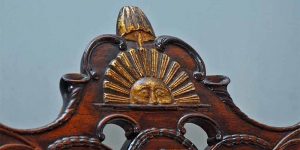
“Now at length I have the happiness to know that it is a rising and not a setting sun.”
Ben Franklin uttered these words on September 17, 1787, at the conclusion of the Constitutional Convention. He was looking at George Washington’s chair which was topped with half a sun and rays shining forth. Franklin, of course, was passing judgment on the work just completed in fashioning the very document in amended form that continues to constitute We the People to this very day.
Franklin’s comment was an expression of hope and optimism. He used the sun metaphor to exclaim his positive feelings about the Constitution. Franklin did not invent optimism in America, but he certainly exemplified it. As the oldest member of the Convention, he had the longest view of what had occurred in the time since even before the French and Indian War to the new beginning after the American Revolution. Even in his old age, Franklin embraced the future with faith and confidence that became part of the American cultural heritage.
In 1932, one hundred forty-five years later, America was depressed. That old-fashioned optimism seemed obsolete in the face of the mounting challenges that had overwhelmed the country for several years. A new President was elected, Franklin Delano Roosevelt, a name that has been in the news lately due to the new President today.

Franklin Roosevelt did not draw on the sun metaphor of Franklin, Benjamin, at least not directly. But his campaign song did. “Happy Days Are Again” would become indelibly etched in the American cultural heritage as the Republican-written post-World War I song about returning veterans acquired a new meaning. It would be vigorously sung anew by Barbra Streisand among others as a clarion call to the positive outlook that is at the essence of the American Dream and way of life. And, yes, there is a shining sun.
Happy days are here again,
The skies above are clear again
Let us sing a song of cheer again
Happy days are here again.
Altogether shout it now
There’s no one who can doubt it now
So let’s tell the world about it now
Happy days are here again,
Your cares and troubles are gone
They’re be no more from now on
Happy days are here again,
The skies above are clear again
Let us sing a song of cheer again
Happy days are here again,
So long sad time, so long bad time
We are rid of you at last
Howdy gay times, cloudy gray times
You are now a thing of the past
Happy days are here again,
The skies above are clear again
Let us sing a song of cheer again
Happy days are here again,
Altogether shout it now
There’s no one who can doubt it now
So let’s tell the world about it now
Happy days are here again,
Your cares and troubles are gone
They’re be no more from now on
Happy days are here again,
The skies above are clear again
Let us sing a song of cheer again
Happy days are here again,
Happy days are here again,
The skies above are clear again
Let us sing a song of cheer again
Happy days are here again.
(Source: Musixmatch, Songwriters: Jack Yellen / Milton Ager, lyrics © Wb Music Corp.)
Could this song be sung again today? Who would you choose to sing it?

In 1984, fifty-two years after Roosevelt and nearly two centuries after Franklin’s declaration, Ronald Reagan’s “It’s Morning Again in America” became the definitive successful presidential campaign ad. The phrase lives on usually without the “again,” a testament to the hope and optimism that continued to define this country. Part of American Exceptionalism has been this indestructible fully-embraced belief in a better tomorrow, in the best is yet come, in life is worth living. That deep-seated faith has drawn millions to this land. People who want a seat at the table in the room where it happens come to America and thrive here to fulfill dreams and live lives they could not at home.
Until recently. One President changed the song, altered the vision, and lost faith. The legacy of the one-term 45th President will include that the presidency was inaugurated and departed in carnage. It became with an inaugural description of America that resembled the landscape of Blade Runner or a Batman movie. It ended with an attempted insurrection to overthrow the government. January 6 will join December 7 and September 11 as a day of infamy in American history (and as April 12, 1861 has not). Instead of embracing America’s future, this loser sought an imagined American past, an America he knew when he was a child. It is a vision shared by tens of millions of Americans who no longer have the optimism and hope for the future expressed by Benjamin Franklin, Franklin Delano Roosevelt, and Ronald Reagan unless their Lord and Savior, the Chosen One, Blessed Be his Name can restore it.
Our current President seeks to renew that faith and optimism, to lift us from the viral carnage of the previous President. On April 28, 2021, in an address to a joint session of Congress, President Joe Bidden drew on the American legacy while acknowledging that it is being tested at home and abroad.
Can our democracy deliver on its promise that all of us – created equal in the image of God – have a chance to lead lives of dignity, respect, and possibility?
Can our democracy deliver on the most pressing needs of our people?
Can our democracy overcome the lies, anger, hate and fears that have pulled us apart?
With these words, Biden harkened to the challenge faced by Roosevelt compounded by the ongoing effort of the previous President to tear America apart far beyond what Robert E. Lee and Jefferson Davis did. They sought to secede from the United States, not to overthrow the government and rule the entire country. This time the stakes are far higher.
America’s adversaries – the autocrats of the world – are betting it can’t.
They believe we are too full of anger and division and rage.
They look at the images of the mob that assaulted this Capitol as proof that the sun is setting on American democracy.
Here President Biden draws on the sun imagery of Franklin. Without specifically saying so, he is addressing the claim Abraham Lincoln made in his annual address to Congress on December 1, 1862 about the United States as the last best hope on earth. Like Franklin, Biden envisions a rising sun but it won’t be easy.
They are wrong. And we have to prove them wrong.
We have to prove democracy still works.
That our government still works – and can deliver for the people. ….
The autocrats will not win the future.
America will.
The future will belong to America.
Perhaps no one expected this President to join the ranks of his illustrious predecessors in boldly championing America’s future. Stirring oratory is not his political past. Yet for one moment and the right moment, he rose to the occasion to vigorously embrace the future that is stunning in its rejection of his predecessor’s carnage.
I stand here tonight before you in a new and vital hour in the life of our democracy and our nation.
And I can say with absolute confidence: I have never been more confident or more optimistic about America.
We have stared into an abyss of insurrection and autocracy — of pandemic and pain — and “We the People” did not flinch….
With light and hope, we summoned new strength and new resolve.
To position us to win the competition for the 21st Century.
On our way forward to a Union more perfect. More prosperous. More just.
As one people. One nation. One America.
It’s never been a good bet to bet against America.
And it still isn’t.
We are the United States of America.
There is nothing – nothing – beyond our capacity – nothing we can’t do – if we do it together.
Amen.






